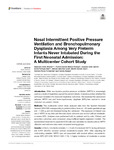Mostrar o rexistro simple do ítem
Nasal intermittent positive pressure ventilation and bronchopulmonary dysplasia among very preterm infants never intubated during the first neonatal admission: a multicenter cohort study
| dc.contributor.author | Ávila-Álvarez, Alejandro | |
| dc.contributor.author | García-Muñoz Rodrigo, Fermín | |
| dc.contributor.author | Solís-García, Gonzalo | |
| dc.contributor.author | Pértega-Díaz, Sonia | |
| dc.contributor.author | Sánchez Luna, Manuel | |
| dc.contributor.author | Iriondo-Sanz, Martín | |
| dc.contributor.author | Elorza Fernández, Dolores | |
| dc.contributor.author | Zozaya, Carlos | |
| dc.date.accessioned | 2023-02-07T12:11:57Z | |
| dc.date.available | 2023-02-07T12:11:57Z | |
| dc.date.issued | 2022-04-27 | |
| dc.identifier.citation | Avila-Alvarez A, García-Muñoz Rodrigo F, Solís-García G, Pertega-Diaz S, Sánchez Luna M, Iriondo-Sanz M, Elorza Fernandez D, Zozaya C. Nasal intermittent positive pressure ventilation and bronchopulmonary dysplasia among very preterm infants never intubated during the first neonatal admission: a multicenter cohort study. Front Pediatr. 2022 Apr 27;10:896331. | es_ES |
| dc.identifier.issn | 2296-2360 | |
| dc.identifier.uri | http://hdl.handle.net/2183/32446 | |
| dc.description.abstract | [Abstract] Introduction: While non-invasive positive-pressure ventilation (NIPPV) is increasingly used as a mode of respiratory support for preterm infants, it remains unclear whether this technique translates into improved respiratory outcomes. We assessed the association between NIPPV use and bronchopulmonary dysplasia (BPD)-free survival in never intubated very preterm infants. Methods: This multicenter cohort study analyzed data from the Spanish Neonatal Network SEN1500 corresponding to preterm infants born at <32 weeks gestational age and <1,500 g and not intubated during first admission. The exposure of interest was use of NIPPV at any time and the main study outcome was survival without moderate-to-severe BPD. Analyses were performed both by patients and by units. Primary and secondary outcomes were compared using multilevel logistic-regression models. The standardized observed-to-expected (O/E) ratio was calculated to classify units by NIPPV utilization and outcome rates were compared among groups. Results: Of the 6,735 infants included, 1,776 (26.4%) received NIPPV during admission and 6,441 (95.6%) survived without moderate-to-severe BPD. After adjusting for confounding variables, NIPPV was not associated with survival without moderate-to-severe BPD (OR 0.84; 95%CI 0.62–1.14). A higher incidence of moderate-to-severe BPD-free survival was observed in high- vs. very low-utilization units, but no consistent association was observed between O/E ratio and either primary or secondary outcomes. Conclusion: NIPPV use did not appear to decisively influence the incidence of survival without moderate-to-severe BPD in patients managed exclusively with non-invasive ventilation. | es_ES |
| dc.language.iso | eng | es_ES |
| dc.publisher | Frontiers | es_ES |
| dc.relation.uri | https://doi.org/10.3389/fped.2022.896331 | es_ES |
| dc.rights | Creative Commons Attribution 4.0 International License (CC-BY 4.0) | es_ES |
| dc.rights.uri | http://creativecommons.org/licenses/by/4.0/ | * |
| dc.subject | Bronchopulmonary dysplasia | es_ES |
| dc.subject | Nasal intermittent positive pressure ventilation | es_ES |
| dc.subject | Non-invasive ventilation | es_ES |
| dc.subject | Preterm outcomes | es_ES |
| dc.subject | Very preterm infants | es_ES |
| dc.title | Nasal intermittent positive pressure ventilation and bronchopulmonary dysplasia among very preterm infants never intubated during the first neonatal admission: a multicenter cohort study | es_ES |
| dc.type | info:eu-repo/semantics/article | es_ES |
| dc.rights.access | info:eu-repo/semantics/openAccess | es_ES |
| UDC.journalTitle | Frontiers in Pediatrics | es_ES |
| UDC.volume | 10 | es_ES |
| UDC.startPage | 896331 | es_ES |
Ficheiros no ítem
Este ítem aparece na(s) seguinte(s) colección(s)
-
INIBIC- REUMA - Artigos [184]






